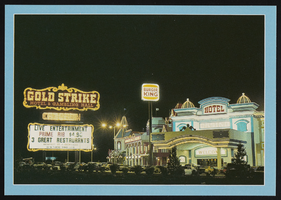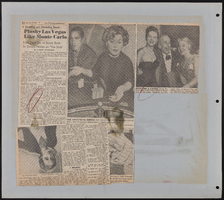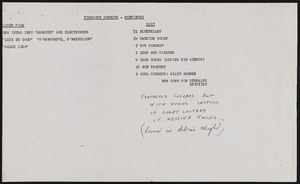Search the Special Collections and Archives Portal
Search Results
UNLV Libraries Collection on Tribal Gaming
Identifier
MS-00917
Abstract
The UNLV Libraries Collection on Tribal Gaming (approximately 1980-2005) contains newspaper clippings, website printouts, government reports, and brochures about tribal gaming policies and regulations across the United States, particularly in Nevada, New York, and Minnesota.
Archival Collection

Transcript of interview with Dr. John P. Watkins by Claytee D. White, April 29, 2009
Date
2009-04-29
Archival Collection
Description
World War II Naval officer, outdoors man, viola player John Watkins arrived in Las Vegas in 1955 fresh from his fellowship at UCLA, as the town’s first urologist. In this interview made two years before his 2011 death, Watkins talks about his schooling, his medical career, and medicine and medical practitioners in Las Vegas from the mid-1950s. He recalls how he met his wife, Frances (née) O’Rourke, and the Las Vegas places he, Frances, and their sons John and Brian lived. In particular, he describes their Desert Inn Country Club neighbors and neighborhood, where he and his family lived for fourteen years near the third tee. Watkins talks about his musical education and playing the viola in Antonio Morelli’s Christmas concerts. He also shares his experiences as a mountain climber who climbed Mount Charleston several times before deciding in his seventies to climb the highest peak in each of the fifty states. By the time of this interview, he and his son Brian had conquered forty-three state peaks. According to his obituary, he completed one more climb before he died at ninety years of age, for a total of forty-four highest state peaks. In an Appendix, Watkins shares his detailed wartime journal covering nine “terrible days” on a U.S. Naval ship in an undisclosed battle zone in the Pacific Theatre, 28 December 1944 – 6 January 1945.
Text

Transcript of interview with Lyla Joy Ford by Anne Cope, March 12, 1975
Date
1975-03-12
Archival Collection
Description
On March 12, 1975, Anne Cope interviewed Tropicana Hotel decorator, Lyla Joy Ford (born December 12, 1928 in Las Vegas, Nevada) in her home in Las Vegas. During the interview, Ford discusses social life in Las Vegas in the early days. She mentions the Palace Theatre, which became the Guild and the El Portal Theatre. She recalls Sammy Davis Jr. performing at the El Rancho but states that people of color were not allowed in the audience. She remembers the Helldorado Parade as a big western celebration. Her family used to own the Old Ranch, also known as the Stewart Ranch. She states that the railroad, Hoover Dam, and the Basic Magnesium Plant brought money into Las Vegas. She also recalls the atomic tests and witnessing the city’s gradual transformation from a small farming town to a major gambling city.
Text
Gaming Gender Equality Index
Level of Description
File
Archival Collection
Women of Diversity Productions, Inc. Records
To request this item in person:
Collection Number: MS-01161
Collection Name: Women of Diversity Productions, Inc. Records
Box/Folder: N/A
Collection Name: Women of Diversity Productions, Inc. Records
Box/Folder: N/A
Archival Component

Gold Strike Inn located in Jean, Nevada: postcard
Date
1993
Archival Collection
Description
Gold Strike Hotel and Gambling Hall, Jean, NV. 1993. (postcard)
Image
Pagination
Refine my results
Content Type
Creator or Contributor
Subject
Archival Collection
Digital Project
Resource Type
Year
Material Type
Place
Language
Records Classification





